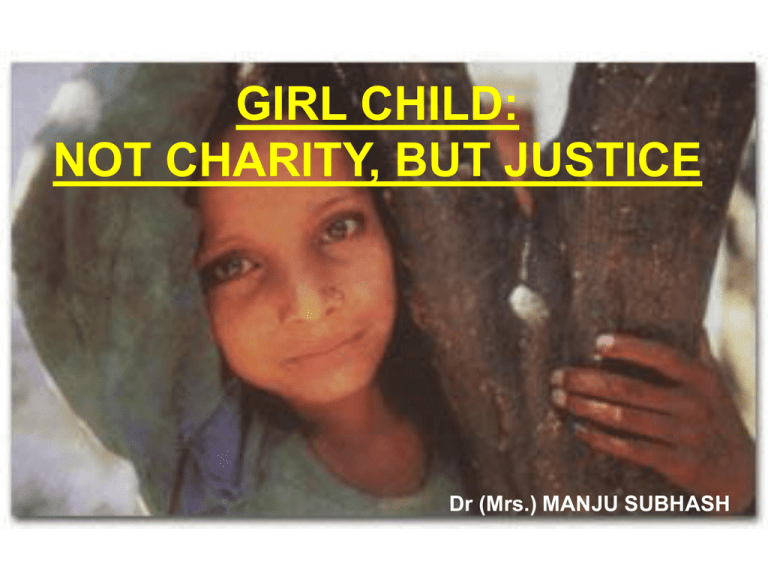
GIRL CHILD:
NOT CHARITY, BUT JUSTICE
Dr (Mrs.) MANJU SUBHASH
Gloom and
resignation at the
birth of girl
Jubilation and
celebrations when
a son is born
BOYS ARE GEMS
girls mere stones
Gender Inequities
Strong patriarchal society
Son preference – sex
selection & infanticide
Sex ratio disparities
Health outcomes
Nutritional status
Gender is a social construct
In contrast to sex, which refers to
biological differences between males
and females, gender is a social or
cultural construct of the differences
between women and men.
People are born female or male, but
they acquire a gender identity that
shapes socially acceptable activities
for women and men, their relations,
and their relative power.
Women - the facts:
The vast majority of the world’s
poor are women and girls.
Women and girls are 80% of the
world’s refugees.
Two-thirds of the world’s
illiterates are female.
And, of the millions of children
kept out of school - 2/3 are girls.
‘e’ is for empowerment ?
'e' is for exploitation
Every hour, four women and girls
in India enter prostitution, three of
them against their will.
Girls are subjected to childtrafficking, debt-bondage, forced
labor, pornography, prostitution
and drugs
Social Issues
Gender roles and the missing female
population
Sons are perceived as an asset:
Security for old age (no social
security in India)
Take over the family name.
Sons get better health care, food and
schooling.
100% of them must find a bride and
produce an heir.
One of the greatest sins is not to
have male descendants.
Social Issues Contd.
Mothers breast-feed boys longer
than girls
Mothers themselves are
discriminated against in food and
rest after the birth of a girl
Nutritional & medical neglect of
girls
Daughters are not valued
“Sold” / “rented” as a factory
worker, wife or prostitute.
Social Issues
Contd.
Daughters are perceived as a
liability
Marry and leave home to
provide labor to another family.
Dowries are often to be paid.
A girl in her natal home is
considered a temporary
member, and in her husband's
house, an `outsider'
The Girl Child 7 forms of discrimination
Malnutrition
Poor Health
Lack of Education
Overwork
Unskilled
Mistreatment
Powerlessness
What causes the shortage of
girls in India?
Poverty? YES
Indian culture? YESCombined with son preference
500,000 unborn Indian girls are
aborted every year after sex
screening
Illiteracy, low educational level? YES?
Political or economic system? NO
Temporal trend: CSR 1991-2001
Jammu & Kashmir
Jammu & Kashmir
Himachal Pradesh
Himachal Pradesh
Punjab
Chandigarh
Punjab
Chandigarh
Uttaranchal
Uttaranchal
Hary ana
Delhi
Hary ana
Delhi
Arunachal Pradesh
Arunachal Pradesh
Sikkim
Uttar Pradesh
Rajasthan
Sikkim
Assam
Nagaland
Bihar
Uttar Pradesh
Rajasthan
Assam
Nagaland
Bihar
Meghalay a
Meghalay a
Manipur
JharkhandWest Bengal
Madhy a Pradesh
Manipur
Tripura
Mizoram
Gujarat
JharkhandWest Bengal
Madhy a Pradesh
Tripura
Mizoram
Gujarat
Chhattisgarh
Daman & Diu
Dadra & Nagar Hav eli
Chhattisgarh
Orissa
Daman & Diu
Dadra & Nagar Hav eli
Maharashtra
Orissa
Maharashtra
Andhra Pradesh
Andhra Pradesh
Goa
Goa
Karnataka
Karnataka
Pondicherry
Lakshadweep
Tamil Nadu
Kerala
Pondicherry
Andaman & Nicobar Islands
Lakshadweep
Tamil Nadu
Andaman & Nicobar Islands
Kerala
Ch ild Se x Rat io (0-6 )
< = 921
922 – 968
> = 969
Missin g d at a
Source: CensusInfo, India 2001, Office of
the Registrar General, India
Women’s status: demographic
reality
Sex ratio (0-6 yrs):
Declining trend of sex ratio in India
economically rich states
980
960
940
920
01
91
20
19
81
19
71
19
61
19
51
19
41
19
31
19
21
19
11
19
19
01
900
Source: Census of India, 2001
States
Haryana
Punjab
Gujarat
India
Overall sex Sex Ratio
Ratio (0-6 yrs)
861
819
876
798
920
883
933
927
Source: Census of India, 2001
Low women’s status in India is captured by the declining sex
ratio across most parts of the country
Legal action to stop
female feticide
Medical Termination of
Pregnancy Act ,1971
(amended in 2002)
Pre-Natal Diagnostic
Technique (Regulation
and Prevention of
Misuse) Act, 1994
The Pre-conception and
Prenatal Diagnostic
Techniques
(Prohibition of Sex
Selection) Act, 2003
Child Marriage
Each year thousands
of girls, some as
young as 6 months,
are married to older
boys in weddings
across the Rajasthan
as part of the annual
Akhai Teej, festival
considered an
auspicious day for
marriage.
DOWRY
Cultural practices of
dowry tend to
subordinate women in
Indian society.
Nearly 6000 women a year
are killed because they did
not bring a big enough
dowry -"bride burning" or
"dowry deaths"
Sati in India
Sati is the practice through
which widows are
voluntarily or forcibly
burned alive on their
husband's funeral pyre.
Banned in 1829
Banned again in 1956
after resurgence.
Revival of the practice in
1981 Another
prevention
ordinance passed
in 1987.
The idea justifying sati is that women have worth only in relation to
men. This illustrates women's lack of status as individuals in India
Violence
Throughout a Woman’s Life Cycle
Childhood
Child
marriage
Incest
Female
Genital
Mutilation
Childhood, adolescence and adult
life
Denial of education, health care or
food
Early or unwanted pregnancy
Sexual harassment
Trafficking
Rape
Honor killings
Forced labour
Violence Against Women
Sexual and gender-based
violence, including physical
and psychological abuse,
trafficking in women and girls,
and other forms of abuse and
sexual exploitation place girls
and women at high risk of
physical and mental trauma,
disease and unwanted
pregnancy.
Violence Against Girls
Violence may affect the
reproductive health of women
through:
Increase of sexual risk-taking
among adolescents,
Transmission of STDs,
including HIV/AIDS, and
Unplanned pregnancies.
A girl child, as a result of
violence, may loose selfconfidence, be afraid/angry, and
blame themselves for what is
happening or feel guilty.
• The Role of Law:
• The Indian Constitution, adopted in 1950,
not only provides equal rights and
privileges for men and women, but also
makes special provisions for women. A
series of laws have been enacted from time
to time to raise the status of women. The
five-year plans have placed special
emphasis on providing welfare services for
women. Achievements, however, expressed
in terms of demographic and employment
characteristics show the position of women
to be unequal. This reflects the limitations
of the law to bring about substantial
change.
GIRL CHILD: NOT CHARITY, BUT JUSTICE
Let us begin the task
today-now-and try to
undo the damage
done to her.
Thank You






